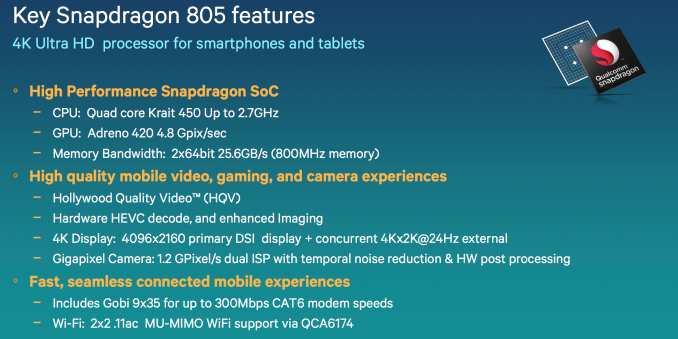Qualcomm Snapdragon 805 Performance Preview
by Anand Lal Shimpi on May 21, 2014 8:00 PM EST- Posted in
- Tablets
- Snapdragon
- Qualcomm
- Mobile
- SoCs
- Snapdragon 805
Final Words
Qualcomm tends to stagger the introduction of new CPU and GPU IP. Snapdragon 805 ultimately serves as Qualcomm's introduction vehicle for its Adreno 420 GPU. The performance gains there over Adreno 330/Snapdragon 801 can be substantial, particularly at high resolutions and/or higher quality settings. Excluding 3DMark, we saw a 20 - 50% increase in GPU performance compared to Snapdragon 801. Adreno 420 is a must have if you want to drive a higher resolution display at the same performance as an Adreno 330/1080p display combination. With OEMs contemplating moving to higher-than-1080p resolution screens in the near term, leveraging Snapdragon 805 may make sense there.
The gains on the CPU side are far more subtle. At best we noted a 6% increase in performance compared to a 2.5GHz Snapdragon 801, but depending on thermal/chassis limitations of shipping devices you may see even less of a difference.
Qualcomm tells us that some of its customers will choose to stay on Snapdragon 801 until the 810 arrives next year, while some will choose to release products based on 805 in the interim. Based on our results here, if an OEM is looking to specifically target the gaming market I can see Snapdragon 805 making a lot of sense. For most of those OEMs that just launched Snapdragon 801 based designs however, I don't know that there's a huge reason to release a refresh in the interim.
I am curious to evaluate the impact of ISP changes as well as dive deeper into 4K capture and H.265 decode, but that will have to wait until we see shipping designs. The other big question is just how power efficient Adreno 420 is compared to Adreno 330. Qualcomm's internal numbers are promising, citing a 20% reduction in power consumption at effectively the same performance in GFXBench's T-Rex HD onscreen test.












149 Comments
View All Comments
Arbie - Friday, May 23, 2014 - link
Yes, but can it run Crysis?Krysto - Sunday, May 25, 2014 - link
No. But Tegra K1 probably can, not just because it's twice as fast, but because it has a much more PC-parity API than Adreno 420.errorr - Friday, May 23, 2014 - link
I wonder what the heuristics are like for switching graphics from TLDR to direct rendering are and whether they are tweaked depending on tablet or phone usage.Abandoning TLDR to use that giant amount of bandwidth is going to use oodles of power. This is why I doubt you will see NV Kepler on a phone and restrict it to tablets.
fteoath64 - Saturday, May 24, 2014 - link
True. Remember NV do have Maxwell shipping on desktop form so its mobile variant is probably in testing/optimization phase right now with possibly reserving it for near future opposition.Krysto - Sunday, May 25, 2014 - link
Denver + Maxwell at FinFET 16nm, now THAT'S a beauty to behold. Hopefully Nvidia doesn't have anymore delays, though.Krysto - Sunday, May 25, 2014 - link
No VP9 decoding? And when is Qualcomm going to open source its baseband firmware? Otherwise we can just assume it's backdoored these days, therefore making the whole phone vulnerable to attacks and espionage.Keermalec - Saturday, August 2, 2014 - link
OK so your excuse, Anand, for not including Tegra K1 or Exynos 5433 in your benchmarks was that you didn't have them available on May 21. Now you do as K1 and Exynos 5433 are shipping while Snapdragon 805 still is not.So can you correct this article to show 805's performance vs the real competition? Pitting it against last year's Tegra 4 and Exynos 5 Octa is just wrong.
HibikiTaisuna - Tuesday, August 19, 2014 - link
Wow, didn't expect that my Tegra K1 is so much better than these SoCs. 50% more graphics performance and even 10% to 20% more CPU Performance (the week part of the Tegra K1).Edwardnew - Tuesday, April 14, 2020 - link
Hi, here on the forum guys advised a cool Dating site, be sure to register - you will not REGRET it https://bit.ly/34EHMey